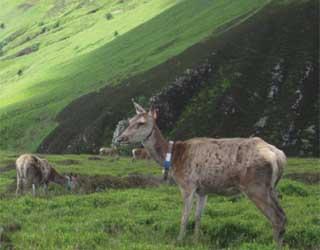How Increasing Red Deer Density is Affecting their Selection of Habitats
Published on 2 April 2014 in Ecosystems and biodiversity

Introduction
Scotland has a red deer population of approximately 300,000. In the last five decades there has been increasing concern that heavy grazing pressure, especially by sheep and deer, imposes a threat to the biodiversity of the Scottish upland habitats. Understanding habitat selection by red deer across the Scottish uplands is key to the management of deer and their impacts on biodiversity and ecosystem services.
Theory predicts that at low densities deer will select their preferred habitats, but as population density increases, the availability of resources declines on preferred habitats, leading to competition. This forces some individuals to use less preferred habitats. As a consequence of global warming, less severe winters and warmer summers are predicted across Scotland. This, together with a decrease in sheep-deer competition, resulting from reducing hill sheep numbers, creates ideal conditions for the deer numbers to increase substantially because of relaxing competition for resources If this situation were to arise, the number of different habitat types used by deer would widen and their impact on less preferred habitats would increase, resulting in degradation of habitats less adapted to grazing.
Key Points
- A team of researchers of the James Hutton Institute has investigated whether increasing deer density has resulted in deer using a greater number of habitats, and how changes in weather conditions have affected changes in preferences for certain habitats.
- Heather moorland and montane habitats were the most and least preferred by deer, respectively, whilst peatland and grassland (Molinia/Nardus and Festuca/Agrostis combined) had intermediate values of preference (Figure 1a).
- At high densities deer favoured grassland, to the detriment of their selection of heather moorland (Figure 1b).
- Habitat selection was also affected by weather conditions; the selection of heather and grassland dominated habitats decreased when temperature increased, while the selection of montane and peatland habitats increased (Figure 1c).
- The deer used a greater number of habitats in winter with increasing population density (Figure 1d).
See Figure 1a, 1b,1c and 1d (PDF file: 343 KB)
Research Undertaken
The researchers used a rich dataset collected by the Deer Commission for Scotland (now incorporated into Scottish Natural Heritage) of winter deer counts in 110 areas across Scotland between 1961 and 2004 (a total of 1,206,495 deer observations) and spatial modelling techniques to assess changes in habitat selection in relation to an increase in deer numbers.
It is predicted that the number of habitats or the intensity that an specific habitat is used by deer is concomitant with an increase in population size, as a greater number of individuals need more space and, because space is limited, more habitats have to be occupied or more animals will be on a particular habitat. The researchers came up with a method that identifies when the number of habitats or number or animals in a habitat increases more than it should be expected to the population being a larger size. The full article can be found online Long-term density-dependent changes in habitat selection in red deer (Cervus elaphus). 2013. Oecologia 173(3), 837-847.
Policy Implications
- Changes in the use of habitats with changes by deer in relation to density and temperature are likely to impact the composition and structure of habitats across Scotland.
- The knock-on effects of changes in the structure and composition of those habitats will impact biodiversity and the ecological processes and ecosystem services.
- In the long term increasing deer densities and climate change are likely to have a detrimental effect on soil and water quality, and may influence the tourism value associated with the hills and mountains of Scotland.
- These findings add weight to the calls to reduce deer density in some areas in Scotland to achieve conservation objectives.
- Taking into account density and weather dependent effects when modelling deer/vegetation interactions will help deer managers understand the consequences of management decisions for economic and biodiversity outcomes, as part of an adaptive management framework in an uncertain and changing world.
This research was funded by the Scottish Government Rural and Environment Science and Analytical Services Division (RESAS).
Authors
Dr Javier P javier.perez-barberia@hutton.ac.uk
Professor Iain Gordon, James Hutton Institute
Russell J. Hooper, James Hutton Institute







